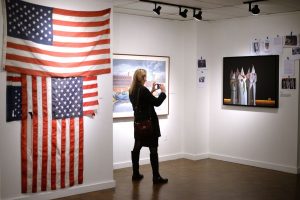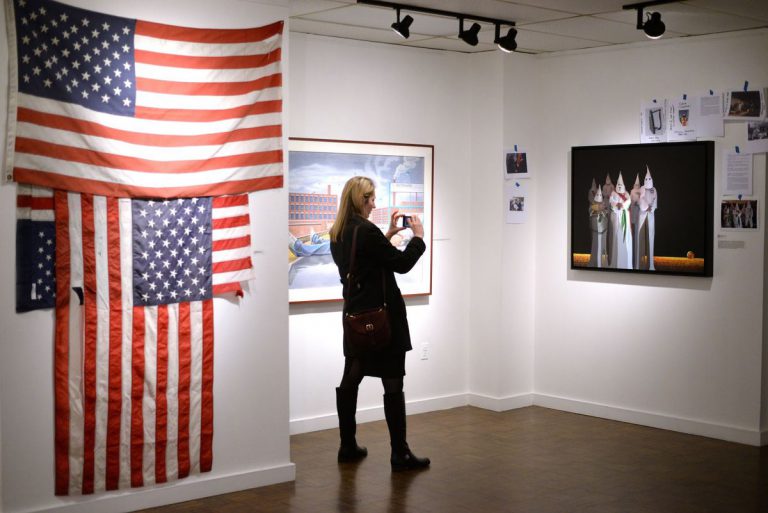
Photo: Paul Bilodeau for Salem News
Over Thanksgiving weekend, at Salem State University in Massachusetts, an art exhibition was temporarily closed after a group of students complained that they found several of the works hurtful and offensive. After a closed-door meeting with fifty students, the university re-opened the exhibition on Wednesday, Nov. 30, but not before making "several modifications."
The exhibition, “State of the Union,” opened the day after the U.S. election at the university’s Winfisky Gallery, and reflects "concerns and hopes for our future" in post-election America, according to a statement by gallery curator Ken Reker. But, according to an article in Inside Higher Ed, because of an the absense of wall labels and other contextualizing materials, students were left to interpret the artworks on their own, and as a result many were upset by the images. Several claimed the works amounted to 'hate speech'. Students were particularly offended by a piece titled “Meeting Under A Black Moon in the Plains of Despair” by Garry Harley that depicts members of the Ku Klux Klan. Harley was surprised by their reaction, since he had intended the work to be a criticism of President-elect Donald Trump and his campaign.
Salem State President Patricia Meservey stated in a press conference that the decision to reopen the exhibition is based on the university's commitment to upholding principles of academic freedom and freedom of expression:
These freedoms include: the scholarship of the curator; the expression of art by the artists; and the right to express dissenting and supportive views by the people who observe the work. […] We acknowledge that we could have done more to prepare our community. The overall outcome of the show offers gains for both those concerned about the exhibit and those concerned about freedom of expression, and builds on our approach all along: creating dialogue.
While reopening the exhibition is a positive outcome on the whole, the university's modifications to the way these difficult works are presented may give them unintended layers of meaning. For example, the choice to hide the KKK piece behind a drapery singles it out as special, and may inadvertently give the KKK the aura of the forbidden and the dangerous.
Of course, art is supposed to be open to interpretation; but this is all the more reason to think carefully about how to present socially relevant and politically charged work that deals with difficult subjects. Work of this sort needs to be framed and contextualized to avoid unnecessary misinterpretations and unwarranted distress. Because of the current political climate, the absence of contextualizing materials often leads to unintended controversy; calls to remove artworks and shut down exhibitions have become increasingly frequent.
In view of student-driven calls for censorship on campus, universities and cultural institutions need to get ahead of the curve when presenting difficult subject matter, be proactive when framing difficult artworks, and supply important context to avoid misunderstandings. They must be prepared to actively engage their students, and they must provide a variety of forums where viewers can voice their criticisms and concerns.
When controversy hits after the fact, such as at Salem State, it is important for galleries and museums to keep difficult artworks on view, and to keep channels for communication open. This can be achieved through gallery talks, open workshops and public programs that address controversial issues with members of the community. But curators, cultural institutions and university administrators need to consider the possibility of controversy before it hits; they can start by familiarizing themselves with the guidelines outilined in our resource, Museum Best Practices for Managing Controversy.


